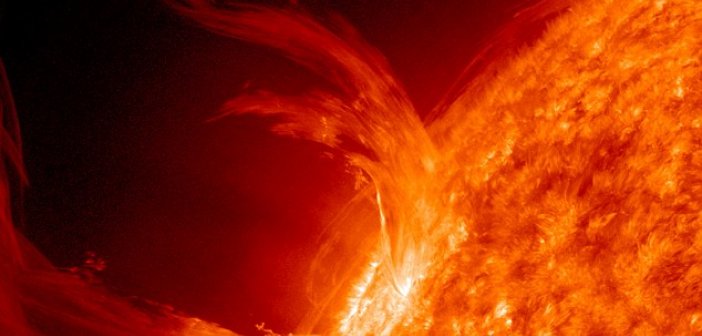The U.S. government are preparing for a catastrophic solar flare which could wipe out power across the world for months.
The last powerful geomagnetic solar storm which hit the earth was in 1859 which caused telegraph lines to explode, setting fire to some telegraph offices, and power to fail across Europe and North America.
In today's far more advanced and technological world, experts the effects would be devastating.
The massive electromagnetic pulse (EMP) from solar flares could wipe out power grids, bringing an end to modern civilization as we know it as cellphones, credit cards and the internet were rendered useless.
In the U.S, alone researchers estimate the cost on the fragile economy would be up to $2.6 trillion, according to a 2008 National Academy of Sciences study.
The report warned that power outages after an extreme solar storm could last months or even longer if it wiped out the transformers.
A catastrophic solar storm came terrifyingly close in 2012 but passed the Earth's orbit without striking the planet.
With scientists predicting a 12 per cent chance that one could hit by 2022, the White House is preparing a contingency plan.
'Frankly, this could be one of the most severe natural disasters that the country, and major portions of the world, could face,' space weather consultant John Kappenman told Gizmodo.
John P. Holdren Assistant to the President for Science and Technology Director, Office of Science and Technology Policy, admitted the solar storms posed a 'significant challenge'.
'Space weather is a naturally occurring phenomenon that has the potential to cause substantial detrimental effects on the Nation's economic and social well-being,' he said.
'This is a real and present danger, this is a real threat,' added Bill Murtagh, assistant director to the Washington Post.
A space weather action plan and strategy have now been drawn up which will focus on preparing the United States for the disaster.
The six-step plan includes establishing a benchmark to accurately measure the threat of events, such as the Richter magnitude scale used for earthquakes and focus on improving forecasting technologies.
One of the big dangers of space weather is that forecasters currently have just 15 to 60 minutes warning time before an extreme event.
The plan would allow for new satellites in space and new technologies on the ground to give a more adequate warning of the disaster.
Research will also be carried out into the potential effects a weather event would have on America and its critical infrastructure, which will allow the government to create a response and recovery plan.
Schools, academia, government agencies, the media, the insurance industry, nonprofits, and the private sector will all be involved if the worst does happen, according to the strategy.
The government has already taken steps towards their goals such as replacing old satellites which are crucial to forecasting the solar storms.
They are also working on a way to protect and regulate the electric grids from a space storm, to stop power being wiped out completely, and are assessing a proposal to replace Extra High Voltage (EHV) transformers destroyed by a solar event.
But the strategy warned that 'much more needs to be done' to protect America from the threat.
The U.S. government are also taking a global view and the last step involves working with other countries to prepare for such an event.
The steps are similar to contingency plans for natural disasters such as hurricanes, earthquakes, droughts and wild forest fires.
(dailymail.co.uk)
www.ann.az





